

Learn. Learn Python - Free Interactive Python Tutorial. Data Science Association. 30 Python Best Practices, Tips, And Tricks. With the holidays behind us, most of us have returned to our day jobs.
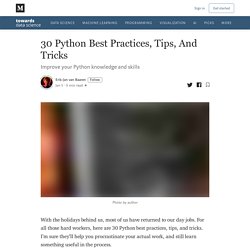
For all those hard workers, here are 30 Python best practices, tips, and tricks. I’m sure they’ll help you procrastinate your actual work, and still learn something useful in the process. In case you missed it: Python 2 is officially not supported as of January 1, 2020. This guide has a bunch of examples that only work in Python 3. If you’re still on Python 2.7, upgrade now. If you’re on MacOS, you can use Homebrew to painlessly upgrade Python. You can check for the Python version in your code, to make sure your users are not running your script with an incompatible version. IPython is basically an enhanced shell. Read the full list here. Another useful feature is referencing the output of a previous command. 30 Helpful Python Snippets That You Can Learn in 30 Seconds or Less. A Visual Intro to NumPy and Data Representation – Jay Alammar – Visualizing machine learning one concept at a time. The NumPy package is the workhorse of data analysis, machine learning, and scientific computing in the python ecosystem.
It vastly simplifies manipulating and crunching vectors and matrices. Some of python’s leading package rely on NumPy as a fundamental piece of their infrastructure (examples include scikit-learn, SciPy, pandas, and tensorflow). Beyond the ability to slice and dice numeric data, mastering numpy will give you an edge when dealing and debugging with advanced usecases in these libraries. In this post, we’ll look at some of the main ways to use NumPy and how it can represent different types of data (tables, images, text…etc) before we an serve them to machine learning models.
Creating Arrays We can create a NumPy array (a.k.a. the mighty ndarray) by passing a python list to it and using ` np.array()`. There are often cases when we want NumPy to initialize the values of the array for us. Once we’ve created our arrays, we can start to manipulate them in interesting ways. Images. Learning pandas [Book] Introduction to Python [Video] Intrigued by Python?
![Introduction to Python [Video]](http://cdn.pearltrees.com/s/pic/th/introduction-to-python-video-200617248)
Learn how to get started with this popular language, whether you’re new to programming or just new to Python. Practical Data Cleaning with Python. Tips and tools for data janitors It's a commonly cited statistic that data scientists spend roughly 80% of their time processing, wrangling, and munging their data and only 20% actually analyzing it.
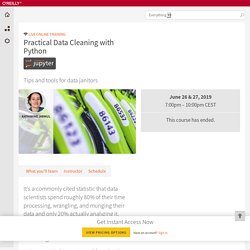
Speeding up the time you spend cleaning your data even a small amount can lead to valuable gains down the line. Join expert Katharine Jarmul for a hands-on, in-depth exploration of practical data cleaning with Python, as she highlights the tools that can help speed up the data wrangling process and automate (or at least allow for general scripting) of some of the repetitive processes. You’ll get an overview of best libraries and tools to use when handling messy data and learn how to apply software development practices to data wrangling problems by writing data unit tests, which allow you to catch problems before they have created innacurate data for your entire company.
Along the way, you’ll explore a few case studies to see the application of these techniques on real-world data problems. ActiveWizards: data science and engineering lab. Natural language processing (NLP) is getting very popular today, which became especially noticeable in the background of the deep learning development.
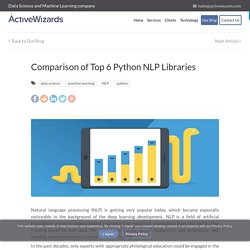
NLP is a field of artificial intelligence aimed at understanding and extracting important information from text and further training based on text data. The main tasks include speech recognition and generation, text analysis, sentiment analysis, machine translation, etc. In the past decades, only experts with appropriate philological education could be engaged in the natural language processing. Besides mathematics and machine learning, they should have been familiar with some key linguistic concepts. Now, we can just use already written NLP libraries. There are many tools and libraries designed to solve NLP problems. General overview. Global Data Science Forum - Data Science. Top 50 matplotlib Visualizations - The Master Plots (w/ Full Python Code) A compilation of the Top 50 matplotlib plots most useful in data analysis and visualization.
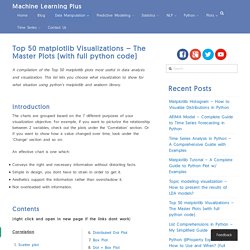
This list lets you choose what visualization to show for what situation using python’s matplotlib and seaborn library. Introduction The charts are grouped based on the 7 different purposes of your visualization objective. For example, if you want to picturize the relationship between 2 variables, check out the plots under the ‘Correlation’ section. Or if you want to show how a value changed over time, look under the ‘Change’ section and so on. The Next Level of Data Visualization in Python. Head First Python, 2nd Edition [Book] Think Python, 2nd Edition [Book] Introducing Chartify: Easier chart creation in Python for data scientists. Why we built a new open source Python data visualization library.

Have you ever been frustrated with the complicated experience of making charts in Python? We have, so we created Chartify, an open-source Python library that wraps Bokeh to make it easier for data scientists to create charts. Give Chartify a try, and you too can easily create charts like these! Chartify is more intuitive than other charting tools Back in 2017, we took a good look how data scientists at Spotify created charts. Despite the abundance of all these tools, chart creation was a major pain point in the data science workflow. Lesser Known Python Libraries for Data Science – Analytics Vidhya. Colorama colorizes the Terminal Output in Python.

It uses the standard ANSI escape codes to colorize and style terminal output. Sometimes it is a good idea to color the logs in the terminal so that if anything goes wrong is stands out. Even though one can manually colorizing output by using escape characters, but that is a very lengthy and tedious task. Colorama offers a simple solution. Just include it into the scripts and add any text to be colorized. Installation pip install colorama. Simple Method of Creating Animated Graphs. Introduction After the publication of one of my latest articles, many people asked me for tips on how to create animated charts in Python. Indeed, there are often situations when a static chart is no longer sufficient and in order to illustrate the problem we are working on we need something more powerful. There are of course many libraries that allow us to make animated and sometimes even interactive graphs like Bokeh, Pygal or my personal favorite Plotly. This time however, we will go old school — I will show you how to create really impressive charts using only “simple” Matplotlib and a few command line tricks.
Inside the article I will place only the most important parts of the code. An A-Z of useful Python tricks – freeCodeCamp.org. Welcome to Python cheatsheet! — pysheeet. Pandas on Ray - RISE Lab. The key differences between Python 2.7.x and Python 3.x with examples. The Python Graph Gallery – Visualizing data – with Python. Automate the Boring Stuff with Python.
The Python Tutorial — Python 3.6.2 documentation. Python is an easy to learn, powerful programming language. It has efficient high-level data structures and a simple but effective approach to object-oriented programming. Introducing Pandas Objects. Welcome back.

Please sign in. Welcome back. {* #userInformationForm *} {* traditionalSignIn_emailAddress *} {* traditionalSignIn_password *} {* traditionalSignIn_signInButton *} {* /userInformationForm *} The Python Tutorial — Python 2.7.13 documentation. Python is an easy to learn, powerful programming language.
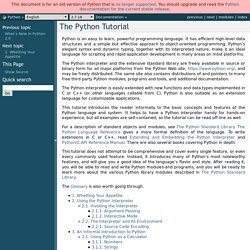
It has efficient high-level data structures and a simple but effective approach to object-oriented programming. Python’s elegant syntax and dynamic typing, together with its interpreted nature, make it an ideal language for scripting and rapid application development in many areas on most platforms. The Python interpreter and the extensive standard library are freely available in source or binary form for all major platforms from the Python Web site, and may be freely distributed. The same site also contains distributions of and pointers to many free third party Python modules, programs and tools, and additional documentation. Requests: HTTP for Humans — Requests 2.18.1 documentation. Top 15 Python Libraries for Data Science in 2017 – ActiveWizards: machine learning company – Medium. As Python has gained a lot of traction in the recent years in Data Science industry, I wanted to outline some of its most useful libraries for data scientists and engineers, based on recent experience.

And, since all of the libraries are open sourced, we have added commits, contributors count and other metrics from Github, which could be served as a proxy metrics for library popularity. Core Libraries. 1. NumPy (Commits: 15980, Contributors: 522) When starting to deal with the scientific task in Python, one inevitably comes for help to Python’s SciPy Stack, which is a collection of software specifically designed for scientific computing in Python (do not confuse with SciPy library, which is part of this stack, and the community around this stack).
The most fundamental package, around which the scientific computation stack is built, is NumPy (stands for Numerical Python). 2. SciPy is a library of software for engineering and science. Presentations & Blog Posts — Conda documentation. Package, dependency and environment management for any language: Python, R, Ruby, Lua, Scala, Java, Javascript, C/ C++, FORTRAN Conda is an open source package management system and environment management system for installing multiple versions of software packages and their dependencies and switching easily between them. It works on Linux, OS X and Windows, and was created for Python programs but can package and distribute any software. Conda is included in Anaconda and Miniconda. GitHub - amontalenti/elements-of-python-style: Goes beyond PEP8 to discuss what makes Python code feel great. A Strunk & White for Python. Sharing Your Side Projects Online and Making Your Github the Best Résumé It Ca. Moving from R to Python: The Libraries You Need to Know.
Why the switch? One of my favorite parts of machine learning in Python is that it got the benefit of observing the R community and then emulating the best parts of it. 10 interesting Python modules to learn in 2016. A gallery of interesting IPython Notebooks · ipython/ipython Wiki. Practical Programming for Total Beginners. Python Cheat Sheet by DaveChild. The One-Stop Shop for Big Data. Runestone Interactive. Scrapekit: Python Library for Writing Web Scrapers.
Google's Python Class - Educational Materials. Learn Python The Hard Way. Learn Python Programming. Python Weekly: A Free, Weekly Python E-mail Newsletter. Online Python Tutor - Learn programming by visualizing code execution. Welcome to Python.org. Python's IDLE editor: How to Use - by Dr A. Dawson. Copyright Dr A Dawson 2005 - 2016 This file is: Python_Editor_IDLE.htm First created: Tuesday 8th March 2005, 7:28 PT, ADLast updated: Saturday 31st January 2015, 9:05 PT, AD. Dive Into Python 3. You are here: • Python Special Edition 1. Think Python: How to Think Like a Computer Scientist. How to Think Like a Computer Scientist.